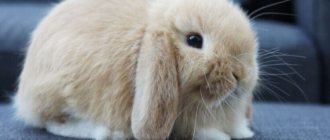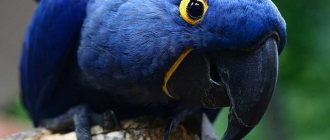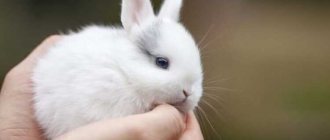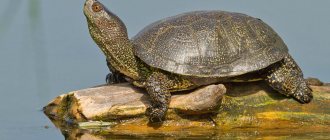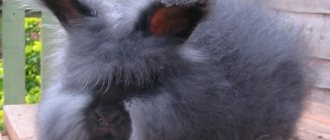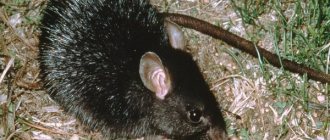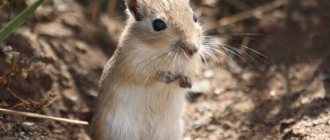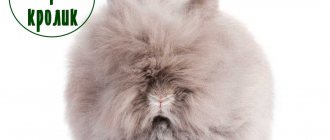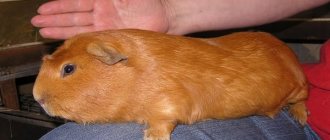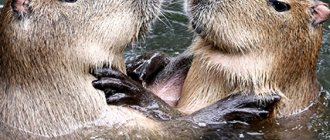- home
- Rabbits
- Breeds
11/09/2018 Rabbit breeding became widespread at the end of the nineteenth century.
First, England, and soon Germany, together with other European countries, became centers for the sale of these furry animals. But it was breeders from the Netherlands who first achieved the appearance of rabbits whose genes contained the code for dwarfism. Such pets are very popular when choosing a pet. They are unpretentious in food, do not damage furniture, do not require constant walking and do not interfere with sleep at night. Rabbits cannot help but charm anyone who has ever held them in their hands and looked into their small beady eyes. Children will really like these animals and will bring a lot of positive emotions and a charge of positivity to the family.
What signs can be used to determine the age of a rabbit?
There are several ways to determine the age of a rabbit by external signs.
For a beginner, this may seem difficult, but with careful and careful study of the animal, you can quickly figure out the issue. You need to learn how to determine the age of rabbits immediately upon purchasing them in order to avoid deception on the part of the seller. First of all, the condition of the teeth of any animal is checked. However, this method is not informative enough, because it gives a rather expanded range.
The teeth of a young rabbit are smooth and light. With age, teeth wear down and darken, and the enamel often becomes stained.
The teeth can be used to determine the age of a rabbit in the range of up to a year or more than a year. In individuals that are more than a year old, the teeth acquire a dark coating. It is almost impossible to determine a more specific age of an animal from its teeth.
Ribs
The ribs can be used to determine the age of an individual in the range of up to six months or more. Regardless of the size of the animal, the ribs of a young rabbit are thin and soft, like cartilage. Rabbits that are more than six months old have hard and elastic ribs.
Claws
Claws often become the main method of “rejuvenating” rabbits for a more profitable sale.
It is important to know the following features and principles of self-determination of age:
- From birth, rabbits' nails are transparent and thin, they can bend when pressed;
- by the age of six months, the claw bends, becomes slightly cloudy and hardens;
- With age, the claws become stronger and acquire a shade corresponding to the color and breed.
Unscrupulous sellers use a simple method of “rejuvenating” rabbits by cutting their claws before selling them.
Eyes
You can also determine the age of an animal by its eyes.
Why you need to study the following information:
- age is determined by the appearance of the upper eyelids;
- in rabbits, the upper eyelids are even and uniform, of the same color;
- the upper eyelids are small at first, but with age they begin to increase in size and sag;
- in adults - aged 6 months and older - the eyelids acquire a characteristic tuberosity, acquire a gray tint and sag;
- Juveniles have clear, brightly colored eyes;
- With age, the lens of the eye becomes cloudy.
The eyes of rabbits should also be examined before purchase to identify any diseases. Often in animals, infectious lesions are manifested by increased lacrimation.
Wool
More accurate information about the age of a rabbit can be provided by the condition of the fur, which undergoes the following changes:
- the appearance of the brood occurs without hair - only after reaching a week of age do the rabbits become covered with thin fluff;
- fur begins to appear at the age of 2 weeks from birth;
- upon reaching 1 month from birth, the first molt begins: it lasts at least 2 months, just when breeders sell animals;
- During the first molt, the fur loses its bright color and falls out, forming characteristic white bald spots, and in places where the fur still remains, the color is gray.
Immediately after molting, the animal begins to acquire permanent hair, with which it lives for the rest of its life - it partially changes during subsequent molts. At the age of 3-4 months, the rabbit gradually acquires soft and thick hair.
If, when selling adult rabbits, the seller assures that they are no more than 4-5 months old, and at the same time the rabbit’s fur falls out or has an unhealthy appearance, then his deception will be obvious to the buyer.
Readiness for mating of a female and a male
As a rule, males begin to show interest in females at the age of 3 months and older, while they may still be fragile after birth. Females reach sexual maturity only at 6-7 months from birth.
You can check the female’s readiness for mating by running your hand along her back in the area just above her tail. If the female rabbit is ready, she will make it clear by her reaction - she will stand in a position that allows the male to crawl up. But it is not recommended to start breeding rabbits at this age. Females must reach sexual maturity, which occurs between 9 and 11 months of age. In males it occurs between 8 and 10 months.
It is also important to pay attention to the condition of the genital organs. The external sexual characteristics of rabbits are formed by 3 months from birth. Adults who have already completed the mating process are distinguished by more obvious forms of genital organs
Adults who have already completed the mating process are distinguished by more obvious forms of genital organs.
How to find out the age of a pet?
It is difficult for an inexperienced owner to determine the age of a pet. However, there are a number of signs that distinguish a young individual from an adult pet.
- With age, teeth turn yellow. Claws. In young animals they are straight, soft and transparent. With age, due to constant growth, the claws begin to bend inward and acquire a yellow tint.
- Ribs. If you feel the softness of the bones when palpating with your fingers, then the baby rabbit has not reached six months of age.
- Teeth. As the animal approaches a year, its teeth turn yellow and dark spots appear on the surface of the enamel. The older the pet, the richer the yellow tint.
- Eyelids. In a young individual, the skin around the eyes is smooth and elastic. As you get older, your eyelids lose elasticity and sag.
- Fur. An adult pet has a thick coat with a thick undercoat. The young animal has a smooth, even and shiny coat.
How to extend lifespan?
For a rabbit to live a long life, it is important to show it love and care. When purchasing a baby rabbit, you should ask about its pedigree, who its father and mother were, what kind of health they had
Knowing what diseases the pet is predisposed to, the owner will be able to pay attention to prevention, working in the right direction.
You can protect your animal from diseases if you vaccinate on time. Vaccinations will help prevent life-threatening infections for your pet.
This is especially important to do if the owner plans to walk the pet outside on a leash.
Physical activity is beneficial for a decorative rabbit. In order for the rabbit to lead an active lifestyle, you should choose a spacious cage, and place ladders, tunnels, and a wheel inside it. It’s good if the animal spends at least an hour and a half a day outside its cage, walking around the apartment, and even better - in the fresh air. These are the main rules thanks to which the decorative rabbit will be healthy and be able to live a long life. Let’s consider what else will help prolong your pet’s lifespan below.
Keeping it clean
The cage is cleaned regularly, cleared of droppings, the floor, bars and trays, drinking bowls and feeders are disinfected. The room where the pet's cage is located should not be dusty. You need to wash the floor and wipe the furniture with a damp cloth.
The cage must be perfectly clean
It is important to keep the animal’s fur clean and comb it out so that tangles do not form. This is especially important during shedding.
If you do not comb the fur, the rabbit, while licking itself, will eat the hair, as a result it may die from intestinal blockage.
Conditions of detention
Rabbits are sensitive to drafts and dampness. When an animal is in such conditions, its immunity decreases. A cold can lead to the death of an animal. Rabbits also do not do well in hot and stuffy rooms. The cage should not be located on the windowsill so that the pet does not suffer from drafts and overheating in the sun.
Nutrition
In addition to feed, the animal’s diet includes good quality hay, vegetables, herbs, and tree branches. In winter, it is worth strengthening his immunity with vitamin and mineral supplements. You can't feed a rabbit:
- sausages;
- meat;
- sweets and pastries;
- wet grass;
- poisonous plants;
- moldy hay;
- rotten vegetables.
Safety
It is recommended to install the pet’s cage on a hill, that is, on a cabinet or table
It is important to ensure that the door is securely fixed so that the rabbit cannot open it itself and fall down. It is unacceptable to drop the animal or step on it: it may die from injuries
The rabbit's place must be safe.
Protection from stressful situations
Do not expose your rabbit to stress. It is better to protect it from collisions with other pets that may frighten the animal. You should not shout loudly in the presence of a decorative rabbit, or use a drill or vacuum cleaner.
Treatment
If your rabbit is sick, you should immediately contact a veterinarian rather than try to cure it yourself. Some diseases develop rapidly and can kill an animal very quickly. Do not neglect routine vaccination.
How long a decorative rabbit will live at home depends in most cases on its owner and on what living conditions he provides for the animal. When purchasing an animal, you need to be ready to give it love and care, spend time and money on treatment, play and walk with the rabbit. Then he will live a long life.
How many years do decorative rabbits live?
The average lifespan of domestic rodents is 8-10 years. Dwarf rabbits live a little less - 7-8 years. Much depends on the conditions in which the animal is kept. With good care, long-eared pets rarely die before the allotted time.
The lifespan of an animal is influenced by the following factors:
- Lifestyle. The rabbit needs to move a lot. Physical activity will help speed up your metabolism and avoid weight gain.
- Diet. Rabbits have a sensitive digestive system, so it is important to monitor your pet's diet.
- Conditions of detention. The rodent must be protected from hypothermia, overheating, temperature changes, and dampness, otherwise it may get sick and die.
- Castration. Veterinarians say that spayed and neutered rabbits live on average 1-2 years longer.
Read in detail about “How long do decorative rabbits live?”
A caring owner can prolong the life of his pet. What is needed for this:
- keep the animal in a spacious cage;
- feed correctly, do not give prohibited foods;
- Vaccinate your rabbit in a timely manner;
- monitor the cleanliness of the rodent’s body and home;
- protect him from stressful situations.
We recommend the article “How to properly feed domestic rabbits.”
The approach of old age is indicated by changes in the behavior of the decorative rabbit. Over time, his activity decreases, he ceases to be interested in games. In older animals, their fur thins, their eyes become cloudy, and their muscles weaken. But we must remember that in old age a pet needs the love and care of its owner even more.
Growth rate
Changes in little rat pups are observed daily:
- On the 3rd day the ears appear.
- Teeth appear on days 8-10.
- After 2 weeks, the nipples of females become visible.
- In the third week, the eyes open and the body becomes covered with fur.
The period of childhood in animals is very short, which is confirmed by the following:
- Within 10 days, the pups grow to the size of an adult mouse.
- After a little more than three weeks, the animals begin to feed on their own.
- After 30 days, the cubs leave the parental nest.
Subsequently, the rats grow until the age of 6 months. After this, they gradually mature and reach their maximum size at about a year.
The smallest breeds of decorative pets
Among dwarf rabbits, those whose weight usually does not reach 2 kg can be classified as small. Thus, according to breed standards, the smallest include:
- shorthaired dwarf;
- Dutch Fold;
- hermelin.
Short-haired dwarf rabbit
The build of this rabbit is similar to that of a wild one. The length of the ears is 5.5 cm. Another name for this breed is “colored dwarf”. These rabbits have about 6 dozen color options. Relatively recently, the white color of a colored dwarf was obtained, which immediately became the most popular.
The “oto” variation of the white color is very popular: on the entire body there is only one spot of a completely regular shape, framing the eye. The weight of the animal is 1 – 1.5 kg. Usually shows aggression only during puberty.
Short-haired dwarf rabbit
Dutch Fold rabbit
The smallest of all lop-eared varieties. A distinctive feature is wide ears hanging on the sides with a clearly defined “crown”. Pointed, narrow or thin ears are not allowed by the standard. Weight 1.5 – 2 kg. Characters are individual. Some people like to be affectionate, while others like to bite.
Polish rabbit (Hermelin)
The second name is “hermelin”. The smallest of all dwarf rabbits and the first dwarf rabbit in history. Distributed in northern European countries. It is not very popular in Russia, most likely due to its thick, warm wool. He can't stand the heat. The weight most often does not even reach a kilogram, although some individuals can grow up to one and a half. The character “on your own” is not suitable for a novice rabbit breeder.
Reproduction
If you have already purchased a purebred individual, you can use it for breeding - this is useful for the animal itself, and allows you to give a fluffy bundle of happiness to your loved ones, and leaves opportunities for good earnings.
Female rabbits become ready to mate early - it is usually recommended to mate them for the first time even before the animal is one year old. It is quite easy to determine that the animal is ready and needs the company of the opposite sex, since the pet’s behavior changes radically - now the female behaves restlessly and is easily irritated. If you have at least once observed the life of rabbits, then you know that they do not need much time to mate - once they are mutually accessible, they almost immediately get down to business. The animals are left alone for a short time, after which they are seated, but the procedure is repeated the next day - this must be done just in case, so that the rabbit definitely becomes pregnant.
The duration of pregnancy in dwarf rabbits depends on various factors, but usually it is exactly one month. At the same time, a large number of cubs usually leads to a fairly early birth, but a small litter, even consisting of fairly large babies, is often slightly delayed.
Caring for a pregnant female is somewhat different - you need to approach the principles of menu formation differently. If in the first two weeks of pregnancy no noticeable differences are observed, then by the third week the rabbits growing in the womb require more and more calories, so the dosage is increased slightly. At the same time, it is undesirable to overfeed a rabbit, because these animals are prone to gaining excess weight, which ultimately leads to health problems. At the same time, it is worth slightly increasing the dosage of cucumbers, as well as some other vegetables and fruits, since, according to some experts, they have a beneficial effect on milk production.
Newborn babies do not hear or see anything, they are strictly forbidden to be separated from their mother - at this stage, only she herself can fully care for them. The person’s task now is to provide a warm place, since even just on the bare floor the babies will die, and to increase the diet for the rabbit.
The behavior of a mother rabbit may seem strange to inexperienced people. First of all, such a mother does not sit around her cubs, but there is nothing unusual in this - even in nature, she would leave them in the hole, while she herself went to look for food for herself in order to produce milk. Despite the fact that you feed the animal and it no longer needs to search for food, the instinct does not go away, so the female only visits the babies indoors, otherwise trusting their will of fate.
At the same time, the owners must closely monitor that the rabbit never remains hungry. The fact is that this peaceful herbivore, being hungry, can easily eat its own cubs!
Rules for caring for a dwarf rabbit
For the full life of any pet, the main thing is for the owner to be aware of all the intricacies of caring for his pet. Caring for a dwarf rabbit is quite simple.
First of all, you should take care of the animal’s nutrition. His diet may include:
- Hay;
- Grass;
- Dry branches;
- Vegetables (carrots, cabbage, etc.);
- Special food;
- Vitamins.
You should not feed your dwarf rabbit human food, sweets, or wet grass. It is also not recommended to give them fruits and berries more than twice a week - an allergic reaction may occur.
Grass and branches help your pet wear down his teeth. Monitoring the condition of teeth is another point on proper rabbit care. At least once or twice a month, your pet will need to shorten its nails with a special nail clipper.
Brush your pet once a week. If he is a long-haired breed, then this procedure should be carried out every day, otherwise tangles will form in the wool.
Dwarf rabbits do not need constant bathing. Water procedures can only be carried out if the animal is heavily soiled; otherwise, it can handle its fur just fine.
How to toilet train an animal
Accustoming a baby rabbit to a litter tray requires a lot of patience from the owner.
The little rabbit is gradually getting used to the toilet, but you will have to be a little patient. It is advisable to remember in which corner the breeder had the tray and place it there at home. It is worth asking the breeder for some used litter and mixing it with the old one. The pet will quickly find its native smell.
If the baby doesn't get into the tray, there's no need to swear. As soon as it becomes noticeable that your pet wants to go to the toilet, you must immediately put him in the litter tray. After a job done successfully, the animal should be praised. If you patiently train your pet to use the toilet day after day, the result will be achieved.
Taming and raising rabbits
Most breeds respond very well to people. During the training process, animals quickly get used to the tray and go into it.
You should play with your pet mini rabbit at precisely set times, as a result the baby will very quickly get used to the desired routine. It is not recommended to disturb pets during eating, sleeping or hygiene procedures.
It will take patience for the baby to get used to the owner, because rabbits are quite shy. However, most individuals are inquisitive and enjoy participating in the game.
List of breeds
Decorative miniature rabbits are so popular that breeders from different countries have bred a good two dozen breeds in just over a hundred years. Their names won’t tell an ignorant person anything, but if you decide to choose a beautiful and furry friend for yourself for many years to come, it’s worth understanding how individual species differ from each other. Let's take a brief look at the most common breeds.
The Dutch, also known as the Danish or Netherland rabbit, is the first colored breed, which made these animals incredibly popular. By the way, he is not so small - with a weight of about 2.5 kilos, he is simply a giant compared to other miniature brothers. It is recognized by a white wedge on its muzzle, pointed upward; at the bottom it turns into a white chest and the same front legs. The sides of the head, ears and back of the body are colored in a different tone, for example, black, blue or chocolate, the line of demarcation of colors is clearly visible. These calm animals learn well and live for about 10 years.
Angora dwarf
It can easily be confused with an ordinary ball of fur. Because of this feature of the coat, it is difficult to see the eyes or nose. It's all about the long fur. It covers the entire area of the rabbit's body, and the fur on its face is especially thick. If you decide to pet an Angora rabbit, you will feel pleasant and soft fur under your hand. It feels like cotton wool to the touch.
There is one variety of Angora decorative type. These animals have shorter fur and are easier to care for. It tangles less. The coat of this breed is smooth and shiny. No more than 5 cm in length.
The body of Angora pets has a cylindrical shape. The head is round, the eyes are shallow-set, the neck is barely noticeable. The ears are short, barely peeking out from behind the fur.
The whole difficulty of caring for Angora rabbits is grooming. Fur requires constant attention. It needs to be combed thoroughly and regularly. If you miss the moment and the fur still gets matted, there is no need to injure the rabbit and try to comb out this lump. Trim any matted fur immediately.
Preparing the site
If a miniature stick-eared animal appears in the house, it is worth preparing a place for it. It should be located at a great distance from the battery and air conditioner. Animals cannot tolerate heat, drafts and direct sunlight. The dwelling is installed in the shade in that part of the room that is not blown through during ventilation.
Keeping dwarf rabbits at home can be in cages or enclosures. The first option is suitable for a small apartment. Cells must meet the following requirements:
- All parts of the cage must be made of special durable plastic or metal so that the animal does not chew them.
- The dwarf domestic rabbit and the length of the cage must be proportionate; the house chosen is 4-5 times the size of the pet.
- Optimal walls are created from a dense mesh, and not from ordinary parallel rods.
- A deep plastic tray is placed at the bottom to make cleaning easier. The mesh floor is not very comfortable; the animal can injure its paws on it.
- A litter tray is placed in one corner. It is better to take a heavy metal one so that dwarf rabbits do not turn it over. Plastic trays are fixed with special fasteners to the bars of the cage.
- On the opposite side of the tray they make a small closed house where the animal can hide and sleep.
- A manger for hay is attached to one of the walls of the cage.
- Containers for wet food and grain are installed inside.
- The drinking bowl is hung next to the feeder.
- A closed pipe, balls and other toys must be placed in the cage.
If there is enough space in the house, they create an aviary. To do this, part of the room measuring 1.2 × 1.3 m is fenced off with a mesh. The optimal height of the screen is 1 m. A waterproof piece of linoleum or thick film is placed on the floor. The top is covered with straw mixed with shavings. An iron tray is placed in the far corner. The enclosure should also have a buried sleeping house, crawling tubes, a wheel and other toys. A manger with hay and an automatic drinking bowl are attached to the net, and bowls for wet food and grain are placed nearby.
What to feed rabbits raised for meat?
One of the important factors that allows you to quickly raise rabbits for meat is good living conditions. To obtain a large volume of dietary meat, rodents must begin to be fattened when they reach two to three months of age. Before this, they are also introduced to the diet as a supplement to mother's milk and do this gradually.
To improve the taste of meat, they begin to pay special attention to the diet - a month before the expected date of slaughter. This period depends largely on the age of the animals and their physical condition.
There are three stages of fattening animals:
- preparatory;
- basic;
- final.
The preparatory stage refers to the time during which a suitable diet is selected. During the main period, animals quickly gain weight. The final one is devoted to matching the weight gained by the animals with the component of fat reserve.
At the preparatory stage, animals should receive high-calorie food. In addition to greens, roughage and succulent feed, double the amount of more concentrated feed is introduced into the diet. If fattening occurs in winter, then the percentage of hay and branches is reduced. However, eared rodents must receive vitamins and minerals in the required quantities. Otherwise, weak immunity can lead to diseases. The preparatory stage does not last long - a few days. The best products for it are mixed feed, legumes, corn, wheat, barley, and oats.
At the main stage, the goal is the formation of a fat layer. To do this, you need products that have a high concentration of fats: sunflower seeds, cake, boiled potatoes. The amount of hay and root crops is limited. Porridge cooked in milk contributes to the accumulation of fat. The health of rabbits should be constantly monitored as they have delicate stomachs. You should not exceed the permissible fat allowance per day. The main period lasts about a week.
At the final stage, special attention is paid to the pets' appetite. It is necessary to ensure that the rabbit eats all the food offered to it throughout the day. To increase his appetite, various spicy stimulants such as celery, caraway, dill and others are added to his food. You can add a little salt to your drinking water. Hay and green fodder are no longer offered, but combined feed is given as much as possible. It should be borne in mind that feeding the animal more grass will make its meat tougher.
Methods for increasing the weight of rabbits that are additional
There are methods also used to increase the weight of fattened rodents:
- Correct grouping. Each offspring contains strong and weaker rabbits. So that they all get food equally, and no one goes hungry, they should, guided by this principle, be seated in different cages,
- Area limitation. Rabbits are active animals and lose some of their weight when they frequently move and run around the cage. To avoid this, part of the cell's territory is limited.
- Increasing the frequency of meals. It is brought up to 4-5 times a day as the feeder is emptied.
Since rabbits are considered nocturnal animals, to increase their appetite, you can darken the cage and offer food at this time. This should not be done constantly, as this may affect the health of the animals.
Vitamin supplements for weight gain
Vitamins should be dissolved in drinking water or mixed into moist bran. Vitamin D is added to porridges. Vitamin C acidifies water. Fattening animals can also be given vitamin and mineral supplements called premixes. The health of rodents will be strengthened by microelements: phosphorus, manganese, calcium.
Sizes: furry giants and babies
During selection, two hundred breeds of animals were bred, and they all differ not only in characteristic habits, color and length of fur, but above all in weight and size.
Breeding standards
The range of values is so wide that all domestic rodents are classified into four main groups:
- Dwarf breeds grow up to 20 cm. Dwarf. For the smallest, dwarf breeds, the standard weight is from 1 kilogram to one and a half. Animals weighing 1.3 kg and measuring no more than 20 cm have an ideal proportion.
- Small ones. The main distinguishing feature of a small ornamental animal from an ordinary meat rabbit is its relatively small weight. An adult rarely exceeds the limit of 2 kilograms with a body length of 25 to 30 cm.
- Average. Rabbits of this group, when growing up, quickly gain weight up to 4 kg, and the length of the body extends to 57 cm.
- Large ones. Real giants, striking the imagination with their accumulated mass. The record weight is 8 kg, and the size of the carcass reaches 70 cm.
Eared giants
Among some breeds, animals of truly outstanding size stand out:
- Eared giant. English fold. The breed is considered the oldest and remains the most popular in England. The weight of an adult giant rabbit reaches 5.5 kg.
- French Fold. At the end of the 19th century, a new breed was obtained by crossing the English and French rabbits, the representatives of which grow up to 6.8 kg.
- Dutch, the weight of the animal reaches 5 kg.
But the real giants are the rodents bred by Soviet breeders in the middle of the last century. Combining the desire to obtain animals with high vitality, precocity and excellent health, scientists crossed the English breed of large animals with local ones, which were distinguished by their large body weight. Thus, scientists obtained giant rabbits with good genetic characteristics:
- Breed Gray giant. Gray giant. The average weight of an adult animal is 4-6 kg, and record-breakers weigh more than 7 kg.
- Soviet chinchilla. The weight of an adult animal reaches 5 kg; for particularly large rabbits it is 7–8 kg.
The leading place in terms of size is occupied by the Belgian Flanders. A long rabbit, growing up to 70 cm, with thick, luxurious fur. Ordinary animals weigh from 7 kg, some grow up to 10-12 kg, and the recorded record is 25 kg.
Dwarf hotot (Blanc de Hotot)
A very rare, and therefore more desirable breed for lovers of rare and beautiful animal breeds. This little animal was bred in Germany, although the French were the first to try to breed this breed.
The average weight of an adult individual barely reaches the 1.3 kilogram mark . A small but very compact body, very short ears, short and strong legs and an amazingly beautiful black eye rim are the characteristic features of this breed. Unlike other dwarf rabbit breeds, they are very playful, sociable, obedient and gentle.
Their fur is dense, shiny and fine. A true dwarf hotot has an exclusively white body color, but with breeding it can also produce another type of color. Today, the breed of colored dwarf hotots has already been officially recognized.
Refusal to feed
Reluctance to feed born offspring may have various reasons. Among them:
Mastitis. Painful sensations associated with inflammation of the mammary glands and hardened nipples can completely discourage a rabbit from breastfeeding. When a disease occurs, the animal needs timely assistance, which guarantees a return to a normal rhythm of life. It is better to confirm suspicions of mastitis with a diagnosis from a specialist who will prescribe the necessary procedures. If mastitis is diagnosed, children should not bother their mother; this must be monitored. Pain when trying to latch on gets worse and becomes the cause of aggression towards the offspring. Schematic representation of mastitis
Hormonal disbalance. Too active behavior of the female the very next day after giving birth indicates a desire to mate. She moves dynamically, chews hay and tears the fluff on her chest. In this state, the animal is dangerous for its offspring; it should be placed in a cage with a male. Usually, after mating, the female calms down and is ready to continue performing maternal duties. A female rabbit needs mating if she actively chews hay the day after giving birth.
External stimuli. Too loud sounds, bright lights, or excessive interest from strangers in the offspring can frighten a young mother and cause a lack of milk. To prevent such a situation, the rabbit needs complete rest before and after giving birth.
Lack of maternal instinct. The phenomenon can be recognized in advance by the behavior of the rabbit before giving birth. Females with weak maternal instincts usually show no desire to build a nest for their offspring. By observing the female rabbit, you can predict possible abandonment of the cubs and prevent aggressive actions.
At best, such a female will simply not pay attention to the newborns; at worst, she will try to bite them to death.
A female rabbit may ignore newborns without showing maternal care.
Care and maintenance at home
Rabbits at home always bring a lot of positive emotions.
- The advantages of these animals:
- attachment to the owners, especially if they surround them with care and affection;
- get along well with a variety of pets;
- very beautiful and clean. They love to be petted;
- not picky eaters;
- they are easy to train, and it won’t be difficult to accustom them to the tray;
- love to play and communicate. If a rabbit and a feline live in the same house, they often play together;
- They can be trained to walk on a harness.
We recommend that you read about how to keep decorative rabbits in an apartment.
However, despite this number of advantages, there are some disadvantages, and for some owners they are much more significant than the advantages of these animals. For example, you can often hear the opinion that rabbits in the house are all wires that have been chewed through.
- Disadvantages of these animals:
- the presence of a specific odor. However, if you regularly clean the rabbit's cage, this problem will not arise;
- if you don’t train the animal to use the tray, then the whole apartment will be marked, and you will find feces in the most unexpected places;
- Rabbits eat excrement very often. This is a normal phenomenon for them, however, feces may contain various dangerous microorganisms that can significantly harm the health of the furry;
- It is simply impossible to keep a rabbit like a cat or a dog, therefore, before getting this fluffy one, you need to buy a cage, a drinking bowl, a feeder, hay and granulated food;
- they very fiercely defend their territory, so you should not climb into their cage in their presence, because they can hit and even bite;
- peace-loving animals in some cases can hiss and growl. This is another way to protect your space from strangers;
- rabbits are nocturnal animals that love to make noise in the cage (throwing around feeders and drinkers, ramming their paws around the cage, trying to gnaw through the bars);
- females become very aggressive during estrus.
In order to make your life easier with these fluffies, you need to know well how to keep rabbits at home and the features of caring for them.
Choosing and arranging a home
In an apartment, it is better to keep decorative rabbits in a cage. It should be placed on the floor, because a fall from a height can have fatal consequences for your pet.
In order for your pet to be comfortable, you need to choose the right cage and organize its corner. It is worth choosing a spacious cage, as these animals lead a fairly active lifestyle and love active games. The optimal cage length should not be less than 70 cm and should be at least 4 times the size of the animal.
They will be able to feel comfortable in such a home. When choosing, you need to pay special attention to the bottom of the cage. Choose a cage with a plastic bottom, because lattice can injure your pet’s paws.
Did you know? Eared animals mark territory with their chin, on which a special gland is located.
Another alternative home in which a decorative rabbit will feel good is a mini-aviary, but it requires quite a lot of space. In the fence you can put not only a tray, a feeder and a drinking bowl, but also organize a mini-area where the animal can frolic.
The bottom of the cage is covered with a layer of hay or sawdust. The thickness of such bedding should be from 3 to 5 cm. The tray where the rabbit will go to the toilet is covered with the same bedding. The cage or enclosure must be located away from drafts, because your pet can catch a cold, and direct sunlight, which can cause heat stroke.
It’s also worth thinking about a mink house where your pet can hide from prying eyes and just relax. However, remember that they spend 16–17 hours a day in such a shelter.
For rabbits, ceramic and hanging feeders are most often used. It is better not to choose plastic ones, as curious rodents can taste them. However, it is worth remembering that rabbits tend to turn everything upside down. It is also worth choosing a hay manger that will be installed on the cage bars. Automatic drinkers are used, and they are attached to the bars of the cage (enclosure).
Although decorative rabbits have thick fur with a downy layer, which allows them to easily tolerate low temperatures, their heat exchange is impaired. That is why it is necessary to provide them with optimal temperature conditions. The ideal temperature is 18–20 degrees Celsius.
Find out in more detail how to make and arrange a cage for a decorative rabbit.
Rabbits tolerate heat very poorly, so in hot weather it is worth installing a bottle of ice in the cage or enclosure, which will allow the animal to cool down. For quick cooling, wipe the animal's ears with a cotton pad soaked in cold water.
Rabbits also do not tolerate high humidity indoors because they cannot sweat. Therefore, it is necessary to monitor this indicator; it should not exceed 50%. From time to time, rabbits can be walked in the fresh air, but this must be done in environmentally friendly places.
This is due to the animal’s need to constantly gnaw, and the grass will become good food. If the grass is dirty, it will cause poisoning. Also, after a walk, you need to check for ticks, which can be carriers of dangerous viruses.
Features of feeding
Despite their small size, rabbits are real gluttons. They need a constant supply of food, because a rabbit eats up to 25 times a day. The main product in the diet of these rodents is hay. It should be of high quality and smell good.
Important! You should not leave hay that the rabbit will eat on the floor, because it will very quickly get wet and spoil from feces. For dry grass it is better to use a special nursery.
At the pet store you can buy a special balanced food that will include grains, dried fruits and other useful mineral supplements. But with such a delicacy it is better to be careful and give in small quantities.
As a treat, it is necessary to provide the rodents with fresh grass, a small piece of apple and carrot. However, such a treat must be introduced from the age of two months. Since childhood, we have been instilled with the idea that rabbits love cabbage very much. Although this delicacy is one of the most beloved, you shouldn’t get too carried away with it, because cabbage makes rabbits’ bellies bloat, so it should be given in minimal quantities.
A small amount of white dried bread will not harm the fluffies. There should always be a branch without leaves in the cage. It can be cut from an apple tree, pear tree, birch tree, rowan tree or currant bush. In winter, you can give a sprig of pine or spruce.
The list of prohibited products for decorative rabbits includes:
- exotic fruits (especially citrus fruits);
- sweets;
- foods with high acidity;
- bakery;
- potato;
- plums
Recommended reading
What not to feed rabbits at home You should also not feed grass that grew near roads.
Don't forget about the teeth, which rabbits must constantly sharpen. To do this, a mineral stone is installed in the cage. It helps not only to grind down the incisors, but also to replenish the animal’s body with minerals that it does not receive from food.
For a balanced diet, the rodent’s menu should include:
- hay -150–200 g;
- green grass - 8% of the rabbit’s weight;
- vegetables - 1–1.5 cups per kilogram of live weight;
- fruit - 1 tbsp. l. no more than four times a week;
- specialized food - 1-2 tbsp. l.;
- salt - no more than 2% of the total feed volume.
Hygiene and cleaning of the premises
Dwarf rabbits can live up to 10 years. However, in order for the animals to always be healthy, you need to know how to care for them. Miniature rodents require constant care. You need to clean your eyes and ears every day. The eyes should not turn sour. Wax should not accumulate too much in the ears. However, if you notice these signs and there is an unpleasant smell from the ears, then you should urgently take your pet to the doctor.
Many owners of decorative rabbits often ask whether it is possible to wash their pets. The opinion of experts is ambiguous. Many of them are skeptical about this issue, because in the process of bathing a rabbit can lose the protective lubricant of its skin. This can lead to hair loss and itching.
In addition, the animal may catch a cold, and the procedure itself will cause severe stress. Therefore, many do not recommend washing rabbits, justifying this by the fact that, if necessary, the animal will lick itself.
Important! When bathing a rabbit, do not get its face and ears wet. Shampoo and water can get into your eyes and ears, leading to serious health problems.
Bathing is recommended in the following cases:
- for preventive purposes - once every 6 months;
- as an emergency aid in case of heatstroke or if the pet is in danger of it;
- if your pet's fur gets dirty.
When bathing, you must use a special shampoo that does not contain SLS.
Before starting water procedures, it is necessary to close all windows and doors to avoid drafts. In addition, you will need an extra pair of hands; an assistant will hold the animal. Together, wet the rabbit and apply a small amount of shampoo. Gently rub the coat and rinse off the shampoo with plenty of water.
When washing off shampoo, it is better to use a ladle or watering can instead of a shower, as the strong pressure and sound of dripping water may frighten the animal. After you wash off the shampoo, wrap the animal in a clean towel and dry it well. You may need more than one towel. After you wipe the rabbit, do not rush to let it go.
After all, the wool must dry completely. A hairdryer will help speed up this process. However, you should not use maximum speed. It is better to turn it on to minimum and keep it at a distance of 50 cm from the animal.
If the fur of a fluffy is dirty, then the animal can be partially bathed (only the area where there is dirt). The procedure for such bathing is the same as in the previous case. This type of bathing also includes a light shower in hot weather.
We advise you to find out whether you can wash rabbits at home.
However, regular eye and ear cleaning, as well as periodic bathing, are only part of rabbit hygiene. Do not forget that their claws are quite sharp and need regular trimming. Do this 1-2 times every 4 weeks. This procedure must be carried out with extreme caution, as it can damage the circulatory system.
To ensure that the fur of decorative rabbits is always beautiful, it is necessary to comb it once every 7 days. If you have a long-haired breed, you should do this daily. Monitor the condition of your teeth - they should be constantly worn down. Hay, grains, and tree branches will help in this process. If you neglect nutrition, the teeth will grow back quickly, and as a result, the rabbit will lose interest in food due to poor health.
The cage must be cleaned every week. Feeders and drinkers should be washed daily. You should also change the tray every day, or even more often. This will get rid of the unpleasant odor in the house.
The bedding in the cage is changed every other day or when it gets wet. It must be remembered that it must be constantly dry. Complete cleaning of the cage, which involves washing, must be done once every two weeks.
Did you know? Over the course of a year, these animals' front incisors
can grow by 10 cm.
Training and games
The active nature of rabbits requires daily play. If you do not pay due attention to this, then the rabbit, out of boredom, begins to tear off the wallpaper, chew wires and other things. This is why you should not let rabbits roam around the apartment unattended. In addition, he may simply mark his territory somewhere, which will also be an unpleasant surprise for his owners.
It is better to play with the rabbit at a clearly established time, which will be convenient for you. Your pet will also like this and will quickly get used to the routine. But it is also worth considering that rabbits are most active in the first half of the day. You should also not disturb the animals when they are sleeping, eating or taking care of their hygiene.
To start the game you need to lie on the floor. In this position, you will be on the same level as the rabbit, and he will feel more comfortable. To calm the animal, you can pet it or let it climb on you. You need to be patient, because at first the animals are very shy and may not show interest in games at all.
To play with your eared dog, you can use the following items:
- a ball with a rattle inside;
- wooden carrots, which will serve as a good teeth sharpener;
- a box with several holes;
- balloon;
- toilet paper roll cardboard;
- a small piece of natural cloth.
Using these and other items, you can teach rabbits various tricks, such as responding to their name, playing with a ball, or even making them a real skateboarder.
Did you know? The heart of long-eared rodents beats at a speed of 130–325 beats per minute. When they experience fear, the heart may not withstand such a load.
It is necessary to start training only when the animal treats you kindly. In addition, it is worth taking into account his mood and feeling of hunger.
Teaching a rabbit to respond to its name is not that difficult, but it does require some patience. Grab a few treats and call your pet. If he responds to his name, then praise him and give him a piece of treat as a reward.
Repeat this exercise several times a day until the rabbit responds to its name on its own without treats. Remember that the name should be pronounced in the same intonation, then the little ear will remember it faster. Don't be upset if the animal doesn't react to you in any way. This may indicate that he is not interested or hungry. Probably, many have seen a video where a rabbit funny pushes a ball, and it seems that he is a natural football player. Alas, nature did not endow these animals with such an ability, but enterprising owners found a way to teach them such a trick.
It's enough to just hide a piece of treat. You can take parsley or carrots. Call your pet and show him what lies under the ball. In order to get his favorite treat, he will be forced to push the ball with his nose. Repeat this exercise regularly, and after a while you won’t have to hide the treat, and the animal will be more willing to push the ball.
It’s also not very difficult to make a real skateboarder out of a little eared dog. True, for this you will need a small skateboard, the size of which will not be larger than the animal itself. First, you need to teach the animal to calmly react to a skateboard and riding it. To do this, the animal is called and a treat is placed on the skateboard, and when the animal climbs onto it, it is gently rolled.
Learn how to catch a rabbit.
You can simply put the rabbit on such a vehicle and ride it around. Over time, when he adapts, you can put the skateboard on top of some plane and call the fluffy one. A piece of treat will be waiting for him below. To get food, the animal will have to move out. From the outside, this trick looks very impressive.
With the help of praise and encouragement, you can learn various tricks and turn your pet into a real circus performer. When training or regular play, it is necessary to remember that the rabbit himself determines how much to play and what games. Therefore, do not be surprised if your rabbit reacts differently to the same toy on different days. Give the animal the opportunity to independently choose what and how much to play with.
What meat breeds
All rabbits intended for slaughter for meat must comply with GOST. All animals are divided into groups:
- First:
it is usually divided into the first and second subcategories. Animals of this group have well-developed muscles, the dorsal vertebrae are weakly palpable and practically do not protrude, and the hips are well developed and rounded. Fat deposits can be easily felt on the withers, belly and groin. - Second:
in animals the muscles are slightly less developed, and the spinous processes of the dorsal vertebrae protrude slightly. Representatives of the second group have toned thighs, a slightly flat butt, and may have no fat deposits. - Third:
this group includes animals with poor muscle development and protruding vertebrae. They are considered skinny and are not suitable for breeding for meat. Figure 3 shows the main defects that make animals unsuitable for slaughter for meat.
Figure 3. Possible external defects of individuals The hair should not be dirty, tangled or in the stage of active molting. Females should not be in the last stage of pregnancy.
Broiler rabbits belong to the first category, and their fatness must meet the following requirements:
- Dense and well developed muscles, thighs and rump;
- The spinous processes of the dorsal vertebrae are palpated;
- You can feel small fat deposits on the withers.
Animals intended for slaughter for meat can be transported by any type of vehicle, but in accordance with existing rules for transporting animals and poultry in containers, boxes, metal or wooden cages.
Meat rabbit breeds that are suitable for breeding include
(Figure 4):
- New Zealand White:
weight reaches 6 kg, and in one litter the female gives birth to 7-12 cubs. Their soles are down, so the breed can be raised on mesh floors. - New Zealand Red:
females are much larger than males, and after birth, the cubs quickly gain the weight required for slaughter. - Gray giant:
adult weight 5-6 kilograms. The female gives birth to 7-8 cubs, which are distinguished by their precocity, rapid growth and good weight. The meat is of average quality. You can also get large skins. - The Californian breed
is characterized by rapid growth and weight. During the year, the female gives birth to 30-35 rabbits. The skin is of high quality, with thick and dense wool, the meat has a high taste. - European Silver:
animals of this breed are not picky, have a calm character, require a minimum of feed, and tolerate severe frosts. The skin is thick and soft. - Poltava Silver
is a breed that allows you to get juicy and tasty meat. The fur is fluffy and valued for its color. Animals tolerate frost well.
Figure 4. Popular meat breeds: 1 - New Zealand white, 2 - New Zealand red, 3 - gray giant, 4 - Californian, 5 - European silver, 6 - Poltava silver
How to select rabbits for slaughter?
Rabbits that have reached four months of age can be slaughtered. There are differences depending on the purpose of breeding the animals. For meat breeds, an important criterion is gaining sufficient weight. If the maintenance and choice of diet were carried out correctly, then the weight at this age should be about 3-4 kg, depending on the breed of the animal.
To obtain full-fledged skins suitable for further processing, the best option is to slaughter rabbits born in winter. This will make it possible to obtain high-quality and beautiful fur. The skin of rabbits that were born in the summer has a lower price. The cost of this type of raw material will not be too high if young animals are slaughtered.
Table of average weight of different breeds by month
To quickly determine the weight of a rabbit, scheduled by month, without going into detail, many breeders use special tables. You can find them online in all sorts of variations, taking into account different breeds.
As an example, one such table is presented below:
Attention! This list shows only average values, suggesting certain deviations up or down. But these numbers give the breeder a guideline with which to refer in the process of raising animals.
Dwarf fireweed
One of the rare breeds. Or, rather, the most unclaimed ones.
Ognevka got its name because of its characteristic tan color - black with fiery red. Although today you can find varieties with a base color of brown or even blue.
The wool is very soft and iridescent. The eyes and nostrils of the fiery dwarf are gracefully outlined. Dark spots also highlight the animal's belly, chest and ears.
The head and ears are medium in size. The standard length of the ears is up to 10 cm. The body is quite strong; moth grows up to 3 kg.
This breed is active, inquisitive and open to communication with people.
“Ognevka” can be found at the poultry market, for 700-1200 rubles.
But it’s better, of course, to contact a nursery. Prices there start from 2000 rubles. (pet class) from 2500 to 4000 rubles. (breed), from 4000 rub. (show class).
Description of the Colored Dwarf breed
This short-haired dwarf rabbit will be loved not only by children, but also by adult family members. A little miracle called a colored dwarf comes in a wide variety of colors. Here is a list of some of them:
- Siamese;
- blue;
- chinchilla;
- black;
- grey;
- fiery;
- squirrel;
- hotot;
- Havana;
- Japanese;
- Russian;
- Dutch;
- "ren";
- Thuringian;
- white-awned;
- silver;
- luxury;
- red.
For most people, the name “separator” or “luxury” color, of course, will not give an accurate idea of the appearance of the pet, so below in the photo you can see what colored dwarfs look like with some of the listed coat colors.
Colored dwarf - photo
Colored dwarf rabbit, red coat color, name Alice.
Colored dwarf rabbit, cream Sussex color, name Anastasia.
Decorative colored dwarf rabbit, yellow, nickname Benjamin.
All photos used in this article were taken from the website of the decorative rabbit nursery “Valley of the Winds”, the address of which you will find below, in the paragraph on purchasing a baby rabbit.
The body of rabbits of the Colored Dwarf breed is stocky and cylindrical in shape. The front legs are short. The tail is small, tightly fitting to the body. Females do not have dewlaps. The head is large and short. Coat with good shine.
Colored dwarf rabbit, agouti color, nickname Ap.
Colored dwarf rabbit photo, Japanese chocolate color, nickname Buddy.
The colored dwarf is a cream-colored rabbit named Vincent.
History of the breed
The colored dwarf rabbit breed was bred by the German rabbit breeder Hoffmann back in 1938. To obtain it, he crossed an outbred rabbit with the red-eyed Hermelin. Two decades later, at one of the exhibitions in Germany, 24 pets of a new breed were presented, with different colors - blue, Siamese, black, gray, marder, etc.
The European breed standard was published in 1992, and 5 years later a modern standard was released with changes made (for example, the minimum acceptable weight was increased from 0.6 kg to 1 kg).
Choice when purchasing
Of course, the most important criterion is personal preference. However, it is necessary to weigh whether there are opportunities for proper care of the animal at home. In particular, you should think before purchasing a long-haired pet. This will greatly complicate cleaning the apartment, which will have to be done regularly in order to destroy scraps of fur.
All rabbits are small in size, but adults can have relatively impressive dimensions. For a decorative rabbit, it will be necessary to purchase a cage, which will become its place of residence. Its size should be sufficient for the animal to live comfortably. Accordingly, it should not be too restrictive for the residents of the premises, in particular if the apartment is small.
The main criterion is the health status of the future pet. Before purchasing, you should pick up the baby rabbit and inspect it carefully.
You should pay attention to the following circumstances:
- cleanliness of eyes, nose and ears, without foreign secretions;
- fatness in moderation;
- absence of bald spots and scratches;
- conformity to the breed of body proportions.
Particular attention should be paid to the behavior of the small rodent. The well-known timidity of rodents should not be excessive, otherwise taming will cause many difficulties
Normal activity will tell you about your health. The baby rabbit should not sit still. However, his too fast behavior may be a sign of excessive aggressiveness.
An important question is what age should the baby rabbit be when purchasing. Of course, a little fluffy creature causes affection, but it should be borne in mind that if weaned early from mother’s milk, he does not have time to acquire the necessary immunity to diseases. The best age when buying a pet is 2-4 months.
Angora dwarf
It can easily be confused with an ordinary ball of fur. Because of this feature of the coat, it is difficult to see the eyes or nose. It's all about the long fur. It covers the entire area of the rabbit's body, and the fur on its face is especially thick. If you decide to pet an Angora rabbit, you will feel pleasant and soft fur under your hand. It feels like cotton wool to the touch.
There is one variety of Angora decorative type. These animals have shorter fur and are easier to care for. It tangles less. The coat of this breed is smooth and shiny. No more than 5 cm in length.
The body of Angora pets has a cylindrical shape. The head is round, the eyes are shallow-set, the neck is barely noticeable. The ears are short, barely peeking out from behind the fur.
The whole difficulty of caring for Angora rabbits is grooming. Fur requires constant attention. It needs to be combed thoroughly and regularly. If you miss the moment and the fur still gets matted, there is no need to injure the rabbit and try to comb out this lump. Trim any matted fur immediately.
